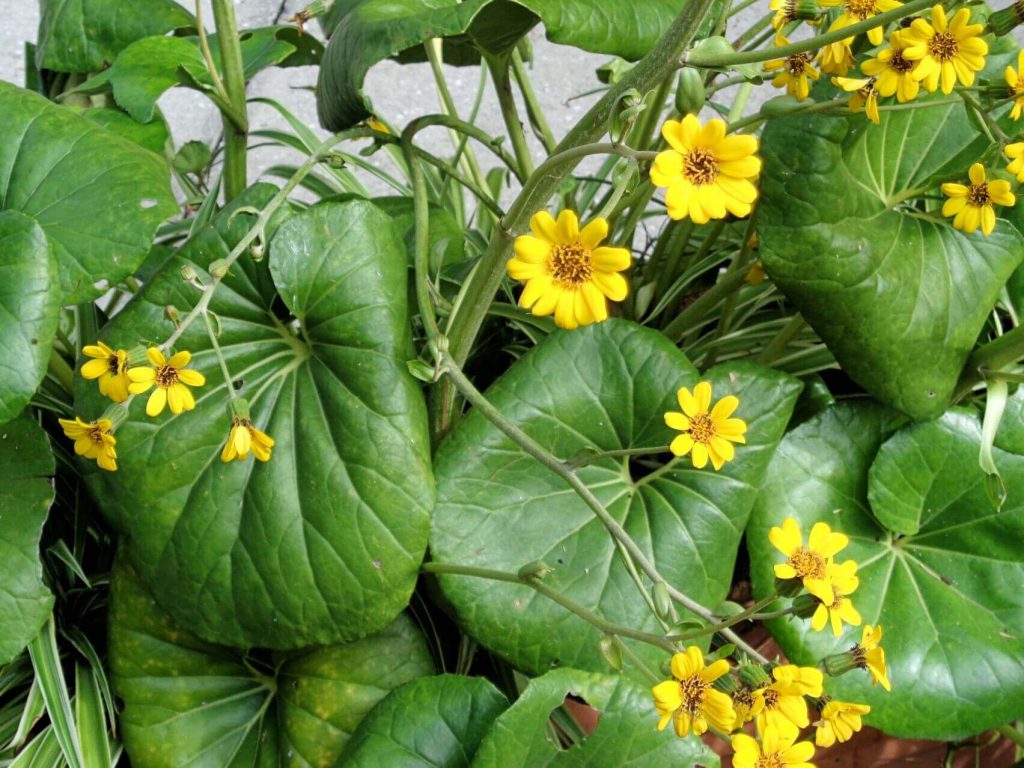 Somewhat new to our area, the perennial known as the leopard plant is an interesting selection that I first saw about six years ago. Besides large, attractive green leaves, the leopard plant also blooms and prefers shade to part-shade conditions. Why is it called the leopard plant? Besides the more common all-green foliage, there are remarkable cultivars which not only have yellow spots, but also variegation and ornamental leaf shapes. Have you spotted a leopard plant as yet?
Somewhat new to our area, the perennial known as the leopard plant is an interesting selection that I first saw about six years ago. Besides large, attractive green leaves, the leopard plant also blooms and prefers shade to part-shade conditions. Why is it called the leopard plant? Besides the more common all-green foliage, there are remarkable cultivars which not only have yellow spots, but also variegation and ornamental leaf shapes. Have you spotted a leopard plant as yet?
The leopard plant originally comes from the warmer parts of Japan and is best grown in hardiness zones 7 to 10. As such, we have the ideal climate for this evergreen plant. The large leaves are somewhat kidney to lily-pad in shape, and in the biggest cultivars, are about fifteen to eighteen inches across in size. One resource also called them the “tractor seat plant” which is a very accurate description! An up-to -two-foot stem gives the collective leaves an impressive feature in any perennial shade garden. And that’s not all! Out of these plants springs a cluster of yellow, daisy-like flowers in fall and early winter.
As the leopard plant does best in shade/part-shade light conditions, take advantage of this somewhat rare characteristic and create gardens under the shade of trees or structures with mass plantings. Leopard plants are also well adapted to large containers for a shady porch or deck. They do like their soil moist, but well-drained, so keep this in mind as you manage the irrigation. Propagation is as easy as dividing the clumps in the spring to expand your collection or give divisions to a friend or neighbor.
While the leopard plants I have seen never looked very leopard-like, and were in fact spotless, the large selection of cultivars is worth investigating. The all-green varieties are locally available, but the fancier cultivars will take an Internet search to acquire. From the pictures I have seen, some that I would like to try include ‘Aureomaculatum’ which sports yellow spots on green leaves, ‘Kinkan’ with yellow-edged leaves, ‘Crispatum’ where the foliage is curled almost like lettuce, and ‘Kagami Jishi’ with both frilly leaves and yellow spots. If you like more impressive flowers, there is even a double-flowering type. You can become a varietal collector of this plant in short order!
Leopard plants may offer you a new plant palette as you create or recreate your garden. This exciting plant will be a conversation starter, and cultivate new fans of this horticultural wonder! For more information on all types of perennial plants suitable for our area, please call our Master Gardener volunteers on the Plant Lifeline on Mondays, Wednesdays and Fridays from 1 to 4 pm at 764-4340 for gardening help and insight into their role as an Extension volunteer. Just as a reminder, our new office is located at the North Charlotte Regional Park at 1120 O’Donnell Blvd, Port Charlotte FL 33953. The Plant Lifeline will also be at our new site starting in 2020. Our phone numbers and email addresses continue to remain the same. Don’t forget to visit our other County Plant Clinics in the area. Our Eastport Environmental Demonstration Garden is always open to the public outside the gate at 25550 Harbor View Road and will continue to be in operation. Master Gardener volunteers tend this garden on Tuesday mornings from 8 to 10 am and are available for questions. Ralph E. Mitchell is the Director/Horticulture Agent for the UF/IFAS Charlotte County Extension Service. He can be reached at 941-764-4344 or ralph.mitchell@charlottecountyfl.gov.
Resources:
UF/IFAS Gardening Solutions – Farfugium. The University of Florida Extension Service, IFAS
Warner, K. (2017) Fact sheet: Leopard Plant. The University of Florida Extension Service, IFAS – Nassau County
Masters A. & Admin. Land of the Giants: The Giant Leopard Plant. Gardenologist. https://gardenologist.org/land-of-the-giants-the-giant-leopard-plant/
Dabbs, A. (2017) Leopard Plant. Clemson Cooperative Extension.
 0
0
